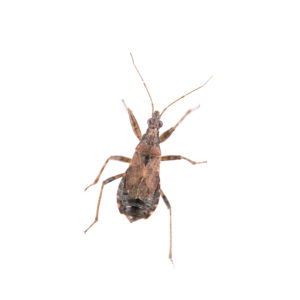 There are several species of kissing bugs. Two of the most common are the bloodsucking conenose bug, Triatoma sanguisuga (LeConte), and the western bloodsucking conenose bug, Triatoma protracta (Uhler). These bugs can be 14 to 24 mm long. They are dark colored, usually brown or black. Some species have red, yellow or tan markings on the abdomen. They are found in many states across the country. Kissing bugs, or conenose bugs, are may feed on animals like raccoons, opossums and wood rats.
There are several species of kissing bugs. Two of the most common are the bloodsucking conenose bug, Triatoma sanguisuga (LeConte), and the western bloodsucking conenose bug, Triatoma protracta (Uhler). These bugs can be 14 to 24 mm long. They are dark colored, usually brown or black. Some species have red, yellow or tan markings on the abdomen. They are found in many states across the country. Kissing bugs, or conenose bugs, are may feed on animals like raccoons, opossums and wood rats.
Kissing bugs got their name early in the twentieth century because they are known to draw blood from the face of the victim. The fact is that these bugs feed on blood from many mammals.
Another common name for kissing bugs is conenose bugs. This name comes from the cone shape of their head. They are also called Triatomid bugs because most of them belong to the insect genus named Triatoma.
Conenose bugs sometimes invade homes, especially in suburban and rural areas. Most people who have been bitten by these bugs were not aware of the bite and had little or no reaction. A small percent of people have an allergic reaction to the saliva of the bugs. These sensitive people have experienced itching, swelling and other allergic symptoms.
REPRODUCTION
The female bug lays eggs in the spring. The immature bugs (nymphs) need a blood meal every time they shed their skin and grow larger. The insects feed at night.
SIGNS OF A KISSING BUG INFESTATION
Kissing bugs are secretive and aren’t not likely to be seen in the open during the day. They sometimes, however, may fly to lights at night. The only other signs would be their bites, but there are many other sources that can result in similar skin inflammation. A physician would need to be consulted to determine the cause of body signs.
Conenose bugs can be medically important. They can carry the protozoa Trypanosoma cruzialso called Chagas disease. The insect’s feces contain the protozoa. The bugs defecate while they feed or soon afterwards. If the person rubs the feces into a break in the skin, he or she could become infected. Scratching the insect bite can introduce the feces into the body.
PREVENTION
There are several steps in preventing kissing bugs. The first step is to keep them from entering the home. Make sure that exterior doors close tightly. Replace missing or damaged weather stripping. Repair any damaged screens on all windows, crawlspace vents and attic vents. Caulk around openings for utility lines, plumbing pipes, and cables. Repair cracks in the foundation of your home so they can not enter. Also, remove and squirrel or wild animal nests and firewood piles that are close to your home. Check your pets and their bedding often to ensure that they do not carry kissing bugs into your home.
Insecticide applications on the outside can help keep kissing bugs from entering your home as well.
